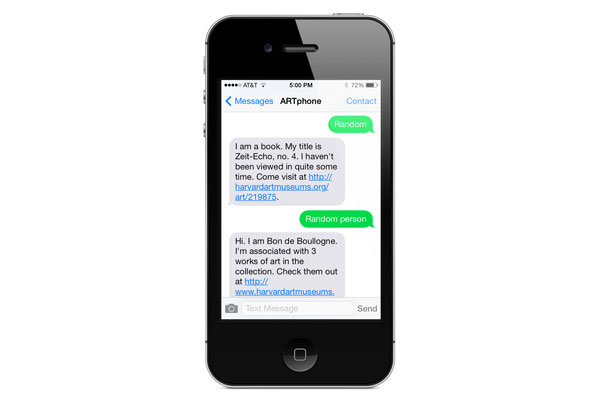Our Digital Infrastructure and Emerging Technology (DIET) department has revealed its latest experiment, ARTphone, which has the power to bring the breadth of our collections—all 250,000 works of art—right to your phone, one object at a time.
Here’s how it works: call 617-500-1866 and press 1 to search the collections by object number, or press 2 to hear about a random object. If you text “random” to the same phone number, you’ll receive a text that gives you information about an individual work of art. If you text “random person” you’ll be sent a text about an artist.
ARTphone is DIET’s latest effort in experimenting with the myriad ways that the Harvard Art Museums can use an application programming interface, or API, to offer deeper access to our collections. API is an interface that taps into our rich database of information related to every object in the museums’ collections. To write the program for ARTphone, DIET staff worked from the open-source code for Cooper-Hewitt’s Object Phone.
“In our research and development, we’re always looking for ways to do extraordinary things with our collections data,” said Jeff Steward, DIET’s director. “With ARTphone, we learned not only that ideas and code from other museums are transferable to us, we also learned that API can live up to its promise.”
ARTphone has shown tremendous potential for reaching audiences beyond the museums’ walls. “For visually impaired individuals,” Steward said, “it could read a description of the work of art. Or it could prompt you to visit the work in the museums and tell you exactly where that object is located. It could even connect you with other users so you could start a dialogue about a work of art. It could offer all sorts of new ways to engage.”
If fully developed, ARTphone could let you access images of the work along with information about the artist, when the object was added to the collections, as well as its provenance, bibliography, and exhibition history. “That depth of data,” Steward said, “sheds light into the deep, dark corners of the collections.”
Working on this prototype proved that accessing art is not just about “the collections hanging on the walls, or the text next to the art in the galleries,” said Steward. “We can expand that experience. The objects now exist physically and digitally, and that digital existence can help us create dialogue between individuals and works of art.”



